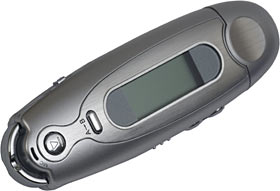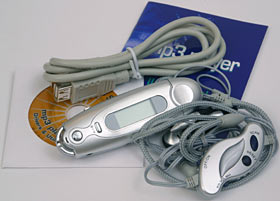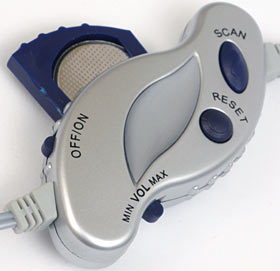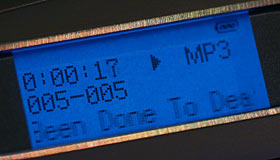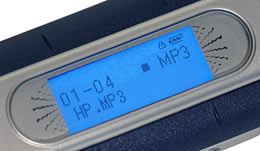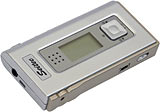
Quick Shot review 3:
TGE MP317 MP3 player
Review date: 12 September 2003.
Last modified
03-Dec-2011.
My review of a couple of SigmaTel-powered, Tai Guen Enterprise-manufactured MP3 players (plus Creative's uninspiring first generation MuVo...) has been updated several times since it first went up. When I first put the review up, it talked about only one TGE player. I called that player "George", because it came in a box with very little identification, and is sold under umpteen different names around the world.
After that came the updated "Fred" - essentially the same thing but with one more button and several fewer bugs.
And now, meet James. Jim, to its (his?) friends. TGE's MP3 player product pages remain gloriously un-updated, but the front of Jim's manual says it's an MP317. This isn't very helpful information, though, because many - if not most - places that sell TGE players don't use the TGE model names for them.
Shiny silver ovoid styling aside, Jim is not terribly different from the preceding players.
It's got a cover you slide off one end to reveal a USB connector (still USB 1.1, but that's not horribly slow for transferring MP3s), and volume and hold switches on one side along with a standard 1/8th inch stereo headphone socket, and a pressable rocker controller on the other side, and play/pause and "A->B" buttons on the face, along with a backlit LCD display. Also like the previous players, Jim runs from one AAA cell and should get decent battery life. And Jim has a voice recorder mode, with a built in microphone. And Jim works as a plain old USB Mass Storage Device when plugged into a PC or, with any luck, Mac; you have to install drivers for Windows 98, but XP and 2000 and probably WinME as well recognise the player natively.
Jim's not spectacularly cheaper than the older incarnations, but the price of all of these things has been sliding steadily downwards. When I first wrote this, Aus PC Market here in Australia were selling "256Mb" Jims (246Mb actual capacity...) for $AU247.50, including Australian delivery, however they are no longer selling it.
So what's new? Glad you asked.
Here's the whole Jim kit. Player, USB extension cord in case you don't have easily accessible USB ports, mildly cryptic little manual, 77mm driver/utility mini-CD, dodgy headphones with neck strap thingy.
What's that in the middle of the headphone lead, though?
It's an FM radio! And it's close to useless! Hurrah!
Jim does not actually have a radio function built in; this fob-thing in the lead does the job. It's powered by a single lithium coin cell (in a drawer, which I partially pulled out for the photo), and its controls are simple.
Turn the radio on with the switch on the side and you're out of listening-to-whatever-the-headphones-are-plugged-into mode and into radio mode. Radio mode works just fine with the headphones plugged into nothing; you can use the 'phones as a standalone radio if you like.
The volume control is a two position switch, with "quiet" and "a bit louder" settings. It's adequate for quiet environments, but wouldn't cut the background noise on a bus.
Tuning is done with one "Scan" button, which just trundles through the FM dial and locks onto whatever strong signals it finds, using the headphone leads as an antenna, as is normal for headphone FM radios. A "Reset" button sends the tuner back to the start of the dial. If the station you want to listen to is 27 strong signals away from the starting point, tough.
The CR2032 cell the radio runs from has lousy capacity into a load of any significance, so I imagine the radio's battery life won't be great. My curiosity about its exact current consumption was insufficient for me to take it to bits and find out, though, because this thing's really just a trinket. If the earphones on the other end of the lead were good, then it'd be somewhat interesting, but they're not. The TGE MP3 players, like many others, come with good looking but bad sounding, highly resonant, midrange-heavy earphones which anybody who cares about their music simply must replace with something, almost anything, else.
This leaves the little radio out in the cold, because it's an integral part of the headphone lead. If the 'phones plugged into the end of the radio, things would be different; this is how the corded remote controls for a number of portable audio devices work, and it's a great idea. But TGE haven't explored it yet.
Thankfully, Jim has some other new features.
Jim's display is improved over the previous models'. More rows of pixels make room for track number, track time and a scrolling track title display (somewhat blurred here, by the half-second exposure of the photo). It's not a night-and-day difference, but it's worthwhile.
Here's George's display, for comparison.
There are also, now, selectable voice record quality levels. The audio is always only four bit (versus 16 bit for normal music files - a four bit audio waveform has only 16 amplitude steps, while 16 bit gives 65536 steps), but you can now wind the sample rate up from the default 8000Hz all the way to 48000Hz. There's a total of seven sample rates, which is a bit excessive if you ask me.
This feature isn't terribly useful, but each step does bring an obvious improvement in the clarity of the sound. 8000Hz is just fine for dictation purposes, though, and the higher sample rates don't make the microphone work any better.
The mic is, by the way, great. All of these players have pleasingly omnidirectional recording abilities, and good sensitivity; moderate background noise is not a problem, you don't need to hold them right up to your mouth or shout at them, and you don't need to be picky about which way the microphone's facing, either. I don't know how great they'd be for recording lectures - you really want a directional mic for that - but as everyday note-takers, they work.
You can use Jim (and, I think, the similarly buttoned Fred) as a press-and-go voice recorder, which is as it should be. George forced you to navigate menus to start recording a clip, which made it useless for the simple press-and-go note-taking for which digital voice recorders ought to be great.
Jim lets you hold the A->B button any time you like, even while playing music, to switch to voice record mode and start recording. The A->B button will turn the player on if it's off, too; one press-and-hold takes you from off to recording.
As before, the voice clips are saved as plain old WAV files sitting in a VOICE directory on the player.
And the FM radio may be pretty quiet, but Jim itself isn't. I'm pretty sure Jim plays louder than either of the previous TGE players, right up to Full Headache Volume through my Sennheiser HD590s. If you've got some vaguely sensitive 'phones to use with this player, you should have no complaints about its noise capacity.
So what's wrong with Jim?
Well, like its predecessors, this player doesn't respond snappily to control input. You often have to wait about a second for something to happen when you press a button, and just tapping a button may get you no response at all. It's OK once you're used to it, but more positive response would be a plus.
Also, Jim still has no real playlist control. This starts to become important with 256Mb players; this much storage lets you put well over 50 tracks on the player. Jim's playlist order is still determined by obscure filesystem order details. This utility may help you order the list, but you'll never be able to do it when the player's not tethered to a computer.
There's also no way to resume a long MP3 (or WMA) from the point where you stopped. Turn the player off and on and it'll remember which file it was up to when it was turned off, but it'll start playing again from the beginning, and you can't even scan through the file terribly quickly.
The USB 1.1 interface is a bit slow if you want to fill the whole player with music, but Jim's capacity isn't high enough for this to be a major issue.
Jim managed a write speed of more than 420 kilobytes per second when I tested it; 246Mb at that speed will take about ten minutes to fill. The read speed's about twice as fast, which you'll enjoy if you're using Jim as a carry-around USB storage device, but it still can't touch any USB 2.0 Flash memory device. Until these players are coming with 512Mb or more memory, though, USB 1.1 will do.
More importantly, Jim will still become very unhappy if you format it from Windows instead of using the formatting utility provided, or if you interrupt a file transfer to the player. You can recover from both problems (I talk about how here in my older review), but it'd be nice if these quirks had been squashed.
Overall
If you've got a George or a Fred, it's unlikely that Jim is going to hold a lot of interest for you. If you're looking for a reasonably priced MP3/WMA player with a good feature list, though, a 256Mb Jim is likely to fit the bill.
Jim looks neat and works a little better than the previous models. It's a shame about the dinky radio gizmo, but you can't have everything.
Recommended.
And another one
Things move fast in the world of off-brand MP3 players. James has already been pushed off the retail shelves by Luke.
